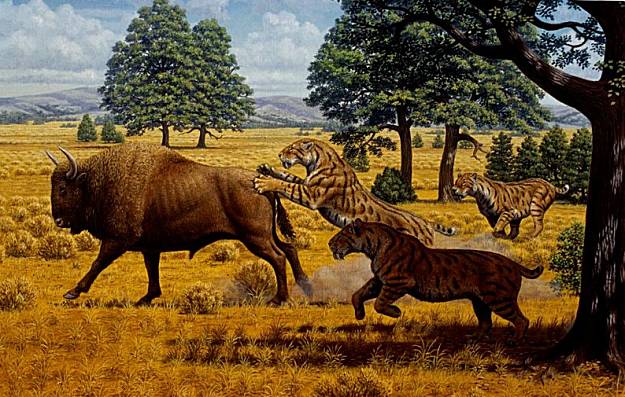
The study of the fossil and archaeological record over the past 30 million years by UC Berkeley and Penn State University researchers shows that between 15 and 42 percent of the mammals in North America disappeared after humans arrived.
That means North American mammals are well on the way - perhaps as much as half way - to a level of extinction comparable to other epic die-offs, like the one that wiped out the dinosaurs.
Anthony Barnosky, a UC Berkeley professor of integrative biology and co-author of the study, said the most dramatic human-caused impacts on the ecosystem have occurred in the last century.
"We are seeing a lot of geographic range reductions that are of a greater magnitude than we would expect, and we are seeing loss of subspecies and even a few species," Barnosky said. "So it looks like we are going into another one of these extinction events."
The analysis by Barnosky, research associate Marc Carrasco and Penn State's Russell Graham was published this week in the scientific journal PLoS ONE. It compares the extinctions of mammals in North America after humans arrived 13,000 years ago to the five mass extinctions on Earth over the past 450 million years.
The least severe of those extinctions wiped out the dinosaurs 68 million years ago and killed off 75 percent of the species on the planet.
Add human impact
Although humans clearly did not have anything to do with the previous extinctions, many scientists are afraid that global warming and other environmental problems caused by the ever-increasing human population could have similarly catastrophic consequences.
"Here we are again, astronomically increasing the number of humans on the face of the globe, plus unusual climate change," Barnosky said. "That seems to be a recipe for extinction that we saw in the past, and we are seeing again."
The work, which was supported by the National Science Foundation, looked at the number, distribution and range of every mammal from shrews to mammoths in the area of the continental United States between 500 years ago and 30 million years ago.
Previous research has shown that most mammal extinctions in North America, Australia, Europe and Northern Asia have occurred within a few thousand years after the arrival of humans. This study puts that data into historical perspective, providing the percentage of animals that went extinct during certain time periods compared with other epochs.
50 gone in 2,000 years
Humans reached North America about 13,000 years ago and more than 50 species disappeared over the next 2,000 years, including mammoths, saber-toothed cats, giant ground sloths and other large animals, according to the study.
The arrival of humans coincided with the end of the last ice age, but the study pointed out that 38 other ice ages had occurred in North America over the past 2 million years and there were no comparable die-offs during the others.
"The only difference is that 13,000 years ago, humans appear on the scene," Carrasco said. "The bottom line is, mammals in general were able to deal with these changes in the past. Only when humans arrive do the numbers fall off a cliff."
There is, nevertheless, reason for optimism, Barnosky said. The number of extinctions has leveled off over the past 10,000 years, he said, and it is not too late to prevent a resurgence.
"If we redouble our conservation efforts, we can stem the tide of extinctions and have those species around in the future," he said. "There is a bit of urgency here. By demonstrating that we have already lost 15 to 42 percent of mammalian diversity, the question is, do we really want to lose any more? I think the answer to that is pretty obvious."
Future studies are expected to analyze the extinctions that occurred 40,000 years ago, when modern humans emerged from Africa into Europe and Asia.
Killed off
At least 50 species went extinct in North America soon after humans arrived on the continent 13,000 years ago. Among the mammals that disappeared were California tapirs, peccaries, lions and cheetahs, llamas, ox, horses, mammoths and mastodons.
Some of the most notable extinctions were: shortfaced bear (Arctodus simus); dire wolf (Canis dirus); sabertooth cat (Smilodon fatalis); American Scimitar cat (Homotherium serum); giant beaver (Castoroides ohioensis); beautiful armadillo (Dasypus bellus); American camel (Camelops hesternus);and Columbian mammoth (Mammuthus columbi).



How verily stupid. We didn't cause the die-offs in the past, but we are now.
"Humans are YOUR enemy".
Who exactly is in charge, please?
Human, you are not.